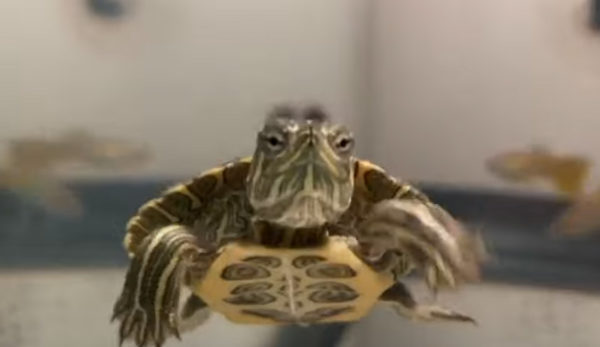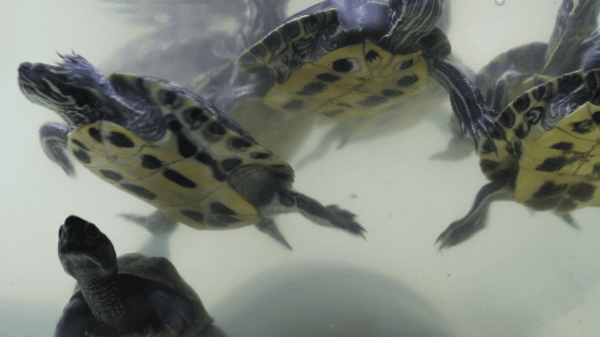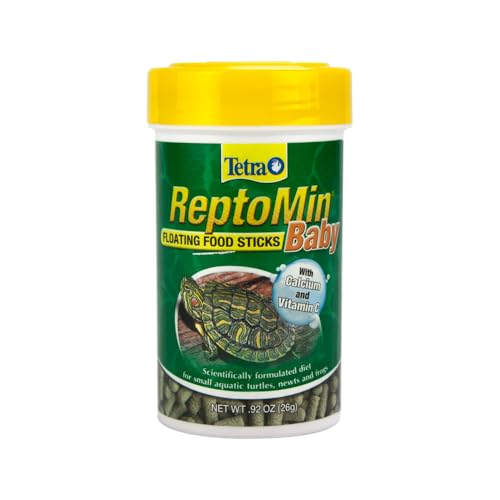Red-eared slider turtles are popular pets and are usually the first adopted from pet stores. Their popularity is because they are super interesting, fun, and unique. These adorable aquatic pets are more challenging to care for, but this guide has you covered with the latest info on their care, diet, tank requirements, and more.
Read to the end before rushing out to buy a red-eared slider, as they are sensitive and not cheap to maintain. But, once you’re into it, you’ll love every second of raising your baby slider.
Table of Contents
What Do Red-Eared Slider Turtles Look Like?
You can identify a Red-eared slider by the distinct red patches at the corners of their eyes. The subtle yellow highlights on their shells also help tell them apart from other turtles. The Red-eared slider is primarily an aquatic creature that comes onto rocks or logs to bask in the sunlight. While basking, Red-eared sliders may even pile up on top of each other. This is where they get their name “sliders” from.
Red Red-eared sliders typically live for 20 to 30 years and grow to an entire foot in length. However, they take a good 5 to 7 years to reach their adult size. Also, be prepared to provide a large tank for them as they require a lot of space.

How to buy a Baby Red Eared Slider Turtle :
Before you rush into the pet store and buy the first slider turtle they have or click “buy” on an online shopping platform, knowing what to look for to get a healthy baby slider is essential. After all, you want a healthy baby Red-eared slider turtle to avoid the pain of losing one after bonding with them.
Inspect the baby slider turtle:
- Make sure there are no holes in their shell. A spot means potential exposure to infection.
- Check if the turtle can swim. The turtle most likely has an infection if it can’t dive deep into the water.
- Look for a glossy finish on the shell of the turtle. If there is a white coating, it means the turtle has been sitting for too long in hard water. If the shell is dull, the turtle has not had enough exposure to UV-B light and could be ill.
- Take a look at the eyes. It is a bad sign if they move too slowly or have sudden movement. Even a slightly yellowish or red tinge on the eyeballs points to an infection.
How to Care for a Baby Red Eared Slider Turtle :

Caring for a baby or an adult Red-eared slider turtle is pretty similar. Most of their care requirements, such as tank size, lighting, basking needs, etc, are the same. What is different is their feeding frequency and meal size.
Baby sliders require careful care, as they are sensitive to environmental changes. They need a nutritious and balanced diet, excellent tank hygiene (that includes a suitable filter), the right amount of light exposure, and a safe basking area.
Sliders are wild animals, and they are reclusive. If you hang around and try to handle them a lot, they will get sick. Keep your interactions with them to a minimum. When they get more used to you, they will choose to watch you through their tank wall. Never stick your face up to the glass to see what they’re up to.
Clean their tank as quickly and quietly as possible, and avoid catching them to do it.
Also Read: Why Do I Need A UV Sterilizer?
Foods that baby Red Eared Sliders Eat :
Red-eared sliders are omnivores, so they eat animal and plant-based food. Do not let their size fool you, though. Even as babies, they eat a lot and need a wide range of food. However, while still babies, they can survive by mainly eating flake and pellet food. The occasional live food is a treat; you can feed them a few mealworms or crickets weekly.
You can feed treats in combination with their regular flake and pellet diet. Remember that overfeeding them with treats is terrible as those foods are rich in fat. Turtles are prone to fatty liver disease.
A good rule of thumb when feeding the babies is never to give them more pellets than the approximate size of their head per meal. Another way to measure it is to provide them with enough food to finish in 5 to 10 minutes. Any more, and it would be overfeeding.
The baby sliders also love eating different types of worms. Bloodworms, earthworms, silkworms, mealworms, and waxworms are all great options to feed baby Red Eared Sliders as a treat. Adding marine food to your baby slider’s diet is a great way to diversify their protein intake. Sometimes, turtles will eat small fish like minnows. Turtles are also known to snack on snails, small shrimp, and other crustaceans. Buy these foods online or at the pet store.
Best Commercial Food for Baby Slider Turtles
There are several commercially produced flaked food, pellets, and sticks specially designed for sliders and other turtles.
1. Tetra ReptoMin Baby Floating Food Sticks
When choosing a food for your baby turtle, it’s always a good idea to choose a food that’s also available in juvenile and adult varieties. This way, you don’t have to change your turtle’s food too much, and you want to try and keep meals as similar as possible to ensure your turtle doesn’t go off their food.
The Tetra ReptoMin Baby floating sticks are ideal as it’s the first step in turtle feeding, and once your turtles are bigger than 2 inches, you can change to the juvenile food without any fuss. Once the turtle has matured, adult food is also in the range.
This food meets all your baby red-eared slider’s nutritional needs. It’s enriched with vitamin C and calcium to ensure great shell formation and adequate skeletal growth, and it also boosts your turtle’s immunity to fight off infection. Since it’s rich in protein, your turtle baby will grow optimally.
Pros
- Soft floating sticks that are the right size so your baby turtle can quickly eat them
- Diverse sources of protein from fish meal, shrimp meal, cracklings, and soybean oil
- Easily digested to prevent bloat
Cons
- Quite expensive for a pack that’s less than an ounce in weight
For young baby turtles, having some live food or freeze-dried food can be helpful when your turtle needs more protein. This turtle food is made entirely of shrimp, mealworms, and crickets. The food is ideal as a treat or to help a poor turtle recover and grow.
With a diverse range of nutrients, your slider babies will thrive on these freeze-dried treats’ 58% protein and 12% fat content. However, if you feed this treat medley, you should take care of overfeeding your turtle.
Pros
- Dense source of protein, fats, minerals, and vitamins to ensure optimal turtle growth
- The soft shells of the insect treats are a good source of calcium and gelatin to help boost the turtle’s shell formation and growth
- The handy screw-top jar makes feeding the insects easy
2. Fluker's Buffet Blend Aquatic Formula Turtle Food
Of course, no turtle can live off treats alone, so getting a balanced meal formula in a convenient form is where these Buffet Aquatic pellets come in. These are ideal transition pellets to feel juvenile to adult turtles. Even your baby turtle can enjoy a few bites from the bits that sink to the bottom of the tank. The pellets soften upon contact with water, so even tiny turtles can manage this food when it’s been soaked.
Simply feed by scattering a few pellets on the tank’s water surface. Watch the turtles to ensure your tank mates get enough to eat. Any leftovers will be scooped up later.
Pros
- Great source of protein at 38% made from fish meal, chicken meal, river shrimp, and mealworms
- Enriched with vitamins and minerals to ensure healthy carapaces, good bone growth, and a thriving immunity
- The food is a combination of pellets and a few whole insects like mealworms, crickets, and more
- Very affordably priced food
Cons
- Smaller turtles may struggle with the whole insects, so cutting up the freeze-dried insects may be on the cards
Also Read: Why Do Turtles Stack And Pile Up On Each Other?
3. Ultra Fresh Floating Baby Turtle Food
Ultra Fresh’s Floating Baby Turtle Food is ideal for 100% natural turtle food specially designed for baby turtles. This food is made from only natural ingredients and contains a great protein-to-plant ratio of 6:4, making it a perfect choice for a growing baby turtle.
To ensure your baby turtle remains healthy, feed these nutri sticks enriched with probiotics that counteract bloat and increase digestion. The probiotic also helps break down the Nutri sticks that sink to the bottom to ensure clean water.
While the sticks maintain their shape, they soften quickly, making it easier for small and baby turtles to feed on these floating sticks.
Pros
- Sword prawns make up the primary protein source of the food, increasing palatability
- Ideal food for picky turtles or baby turtles that don’t want to eat
- Contains a vast range of vitamins and minerals for optimal health
- Probiotics help with digestion and tank hygiene
- Sticks stay intact for 24 hours, making it ideal for turtles to feast the next day
Cons
- Overfeeding can lead to loads of food collecting at the bottom of the tank as it sinks fairly quickly
- Food pellets may be too small for an older and larger turtle baby
4. Zoo Med Natural Aquatic Turtle Food Hatchling Formula
Since young turtles most need protein from animal sources when they have just hatched, a meal mainly containing animal sources is best. Zoo Med’s Natural Aquatic Turtle Food (Hatchling Formula) is ideal as it has the most diverse protein sources. Best of all, this is also a very affordably priced turtle food.
Most ingredients are naturally sourced, and the tiny pellets are free from harmful artificial preservatives, colorants, and flavorings. It’s as nature intended turtles to eat.
- 43% protein for excellent growth
- Micro pellets are small enough for baby turtles to swallow easily
- Pellets sink to the bottom but maintain their shape, making it easier for turtles to eat later
Cons
- While the protein sources are mostly aquatic-based, the poultry meal and blood meal are likely from a factory farm, which raises questions about hygiene
Baby Red-Eared Sliders’ Feeding Routines
Feed your baby slider turtles once daily, and you can give them a small treat every other day. When the turtles have grown a bit (usually at six months old), you can feed them slightly more each meal but only feed them every second day. Turtles have a slow digestive system and metabolism, so feeding too frequently will cause them to bloat.
The turtle’s size is also a good indicator of when to feed them. Feed small and immature turtles under 2 inches long daily, while those bigger than 2 inches require alternating feeding.
Remember, your baby Red-eared slider’s diet should mainly focus on protein.
What to Do If a Baby Red-Eared Slider Won’t Eat?
Young turtles rely on protein to grow; if they stop eating, they could be overeating plant material. Stop feeding plant-based food and switch to animal protein, such as grubs and minnows. For small turtles, you can chop the protein source smaller.
As the turtles grow, reintroduce them to plant-based food, especially food rich in dark green leafy vegetables such as spirulina. Adult sliders only need an animal protein source twice a week.
However, it’s a real challenge when your baby slider won’t even eat animal protein. Usually, baby turtles stop eating when they feel stressed. They duck into their shells and freeze in place, hiding under rocks or in corners of the tank. Sudden changes to their environment or the introduction of other turtles may cause young sliders to stress and stop eating.
Regardless, you have to keep trying to feed your turtle. If the turtle doesn’t eat for several days, you need to consult with your vet, as your slider may be ill. They may have a blockage or picked up an infection.
Check your slider for signs of disease, and if you have more than one slider, you should isolate them in their own little tank inside the larger tank. This stops spreading diseases and keeps your turtle socialized with other sliders to avoid depression.
How to Set up a Baby Red-Eared Slider Tank?
As mentioned earlier, correctly setting up the tank for a baby Red-eared slider is crucial. A few components are essential to a tank that will house your pet baby turtle. You need a robust filter system, a large tank to accommodate the turtle from baby to adult size, a UV heat and light source, a thermometer, a heater (for the water section), and a basking dock.
We recommend going with a 55-gallon tank for your Red-eared slider. If you have a bigger one, great! There’s nothing wrong with having extra space. A basic rule for selecting the tank size is to have 10 gallons of water per square inch of the turtle’s shell.
When it comes to water heaters, use a submersible one. It is inexpensive, but does the required task. You need to have UV-A and UV-B light for healthy turtles. Any UV light with less than 5 – 10 % UV-B output will not meet your turtle’s basking needs.
The heat source you select should be powerful enough to keep the basking area at a pleasantly toasty temperature of 85 to 90 degrees Fahrenheit. Select a basking platform that is large enough to accommodate your turtle while also leaving room to grow.
Also Read: Guppy Fish Water Temperature (Maximum And Minimum)
How to Handle a Red Eared Slider Baby:
As mentioned, turtles do not like being handled. So, keep interaction with them to a minimum. Also, minimize interaction with them as they are also quite dirty. They carry a lot of germs on their body (as they mess a lot) and are known to carry salmonella as well. Always wash and disinfect your hands after handling your turtle. Here are a few handling tips:
- Your red-eared slider may not like being handled, but they are affectionate in their own way. Once they have become accustomed to you, you can try to offer them food by hand, but beware that they may snap at your fingers. With routine, your turtle will even come to say hello.
- They are also very sensitive to vibrations, which could cause them stress. Turtle babies are very fragile. So, they could also get hurt without us meaning to while handling them. Avoid playing loud music near them or moving their tank around.
- Moreover, new turtle hatchlings have soft shells that can be damaged if they are mishandled. Their shell is an extension of their skeleton, and while they love rubbing their shell on leaves, you should never try to brush it for them.
- If you absolutely must handle the baby turtle, do so by scooping it up into the palm of your hand. After you release it back into its tank, wash your hands immediately (salmonella is an exceptionally infectious disease that could be transmitted via the turtle to you).
- Be careful when you put your hand in the tank. The Red-eared slider might bite your finger as it may mistake your finger for food.
Turtle Preparation Check-List
- Get your tank set up before you choose your turtle and buy them.
- The essential components for the tank are a large aquarium, a basking spot with a good heating source, a strong UV-A and UV-B light, a thermometer, a good water filter, and a water heater.
- Examine your turtle before buying to avoid choosing a sick turtle that will cost a lot to treat.
- The tank size should suit your pet turtle’s adult size, not the baby’s.
- Ensure a constant and stable environment by checking the tank water and basking area’s temperature to ensure it’s at the turtle’s preferred heat.
- Only feed food that’s safe and fresh to turtles. Flakes and pellets need to be fresh and not stale. Introduce treats gradually and in small portions.
- Feed your turtle in the water, never on the basking platform.
- Regularly clean out the turtle tank, preferably once every 2 or 3 weeks at least.
- Clean your hands before and after handling your turtle to prevent them from giving you salmonella poisoning and stop you from introducing bacteria to their soft shell.
Final Words
The Red-eared slider is a fun, unique, and easy-to-look-after turtle (once you know what they need). If cared for properly, you have a companion for a long, long time. The Red-eared slider is one of the most popular pet turtles because they can become quite affectionate. As a bonus, their care requirements stay the same as they grow.
You can build an excellent bond with your pet turtle despite a lack of physical contact. After the initial get-to-know-each-other, you can win them over by feeding them regularly, teaching them their name, and entertaining them with turtle toys to bring you closer together.
If you do not handle them too often and care for them correctly, you’ll have a great experience and a friend for decades.
For further turtle reading, check out these guides:




